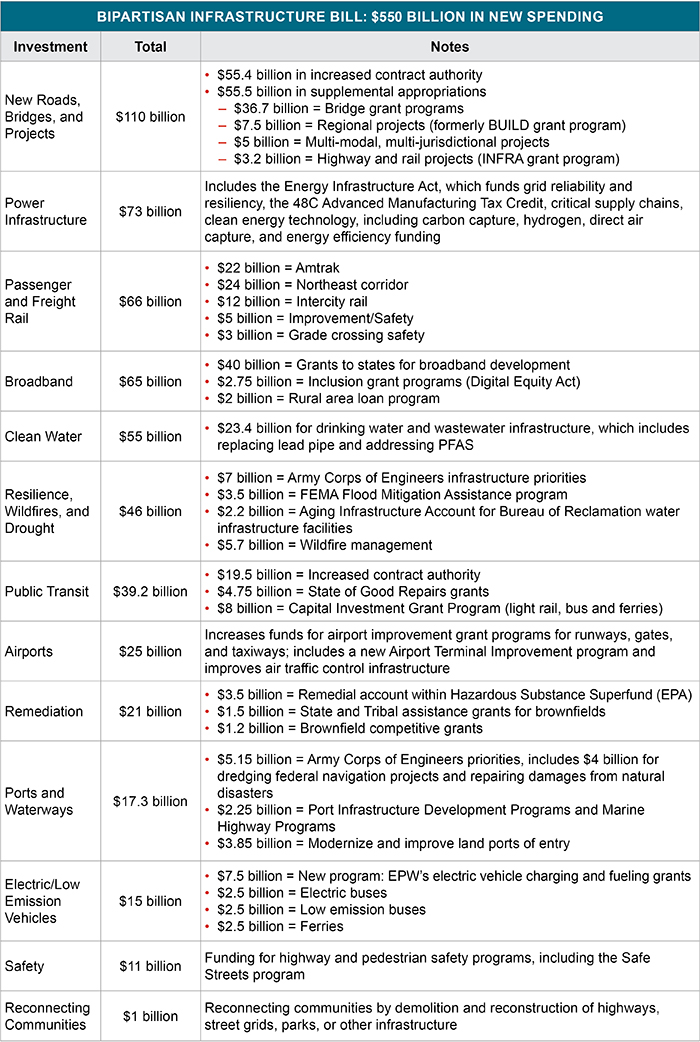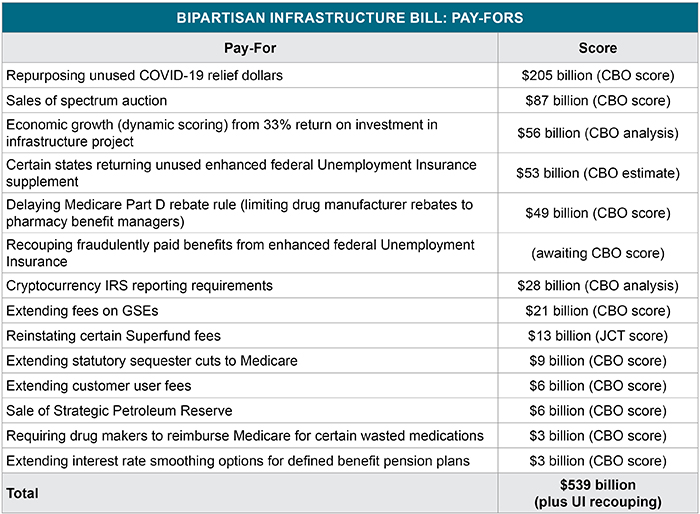For the most current information, please click here.
Introduction
With the almost certain passage of an infrastructure bill, we are on the verge of a once-in-a-generation funding and policy shift that will have massive ramifications across numerous and diverse industries. Some of the coming policy changes will have immediate implications, for example, the investments in power grid improvements, while others will shape markets over the next decade, for example, the commitment to dramatically increase broadband and invest in public transit including electric transit vehicles and charging stations. The Daschle Group and Baker Donelson's public policy group are tracking these developments and will share with you the most relevant information in a timely fashion. This is the first of what will be a series of alerts designed to keep you informed of the negotiations underway and the progress being made.
All the Moving Parts
Infrastructure investments will likely come from three sources over the next two months: a bipartisan infrastructure bill, appropriations legislation, and a reconciliation bill.

- A finalized bipartisan infrastructure bill will include physical infrastructure investments from President Biden's American Jobs Plan at levels that both Senate Democrats and Republicans could agree upon. This bill will also include the Surface Transportation Reauthorization Bill that will continue to fund existing surface transportation programs.
- The FY22 appropriations process is continuing with the House and Senate considering the increases in the annual budget requested by President Biden earlier this year. Infrastructure investments will be primarily split between three of the appropriations bills: Energy and Water, Interior and Environment, and Transportation and Housing and Urban Development.
- The FY22 reconciliation bill will include investments in physical and "human infrastructure" (economic and social policy) from President Biden's American Jobs Plan and American Families Plan along with a host of other Democratic priorities. The drafting and consideration of this legislation could begin in September after the passage of a budget resolution.
Where We Go From Here
Right now, Senate Democrats plan to move the bipartisan infrastructure bill and the FY22 budget resolution through Congress one after the other through what they are calling a "dual track" process. The budget resolution sets non-binding policy changes and budgetary targets and, if passed, would begin the reconciliation process to allow a 51-vote threshold for the final reconciliation bill (so that Democrats can pass legislation without Republican support). Democrats' priorities not included in the bipartisan infrastructure bill could be included in the reconciliation bill.
The Senate voted on two procedural measures to take up and begin debate on the bipartisan infrastructure bill on Wednesday, July 28 and Friday, July 30. The first vote was 67-32 with 17 Republicans, including Republican Leader McConnell (R-KY) voting in favor, and the second vote was 66-28, with 16 of the same Republicans (one missing the vote) voting in favor. Draft text of the bill was recently released. (see summary below) Majority Leader Schumer (D-NY) intends to pass the bill over the weekend.
Notable differences from the prior bipartisan infrastructure framework include less money for public transit and clean energy projects and no Internal Revenue Service (IRS) enforcement money. The legislation includes $550 billion in new spending, which comes on top of extensions of current infrastructure funding to get to approximately $1 trillion in spending. The bill includes the Senate-passed Surface Transportation Reauthorization Bill, the Senate-passed Drinking Water and Wastewater Act, and the Energy Infrastructure Act approved by the Energy and Natural Resources Committee. If passed, it is unclear if the House would take up the bill as written or seek to further amend.
The annual appropriations process is proceeding in the House where a number of appropriations bills have been approved by the full Committee as well as the House. Congressional Democrats have accepted or built upon President Biden's FY22 budget requests. Some of these investments include creating new offices at the Department of Energy, new programs at the Department of Transportation, and expanded grant programs at the Environmental Protection Agency. Currently, all five of the appropriations bills that include infrastructure investments are part of H.R.4502, a combination of seven appropriations bills, which passed the House on Thursday, July 29.
Both chambers are about to take their August recess, but senators are likely to stay into the second week of August to pass the infrastructure bill and then the budget resolution, while House members may come back early from recess to pick up where the Senate leaves off.
New Spending and Pay-Fors in The Bipartisan Infrastructure Bill Known As The "Infrastructure Investment And Jobs Act"


We will continue to track developments with the infrastructure bill and related legislation and will provide updates. For more information, please contact one of the authors of this alert.